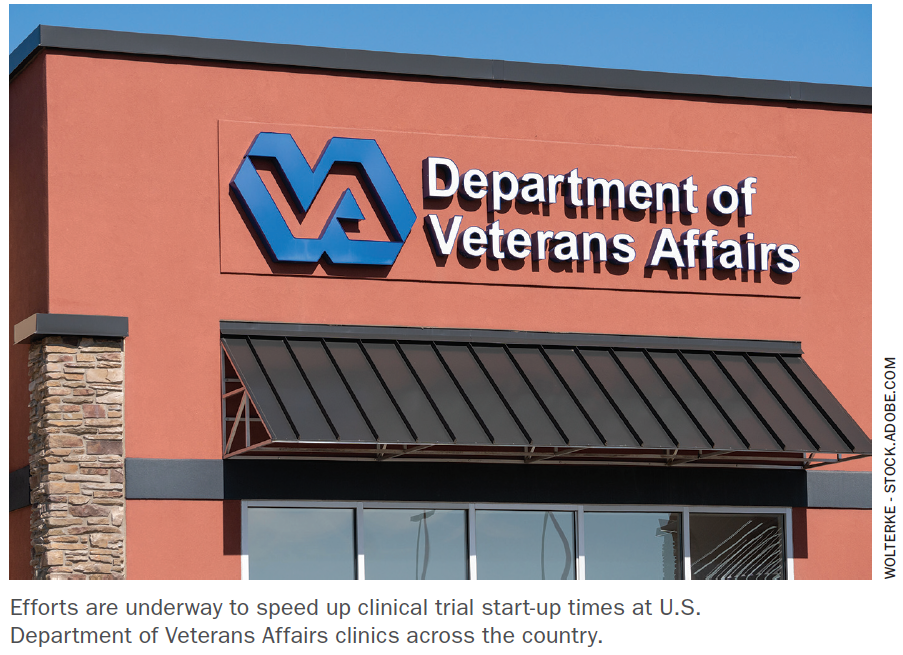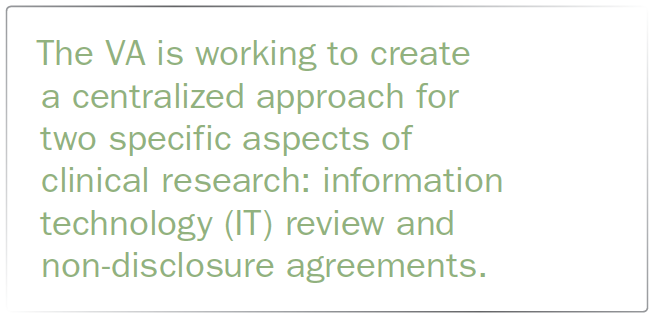The VA Gets Real on Reform
Applied Clinical Trials
After years of siloed focus-and slow study start-ups-the U.S. Veterans Affairs agency embarks on implementing its multi-year initiative to bolster clinical research.

The U.S. Department of Veterans Affairs (VA) has a long history of pioneering clinical research, including first definitive tuberculosis trials in the 1940s, and subsequent studies that led to the first CT scan and implantable pacemaker.
In theory, life science companies should be clamoring to partner with the VA on clinical research. The agency was an early adopter of a unified electronic record system, and its patients are motivated, ethnically diverse former service members-ideal study candidates.
But in recent decades, the VA’s research efforts have remained inwardly focused, with the agency’s strict rules and protocols making it difficult to partner with the private sector. Today, the VA’s study start-up time is 120 days longer than the industry average, according to two independently verified analysis by contract research organizations (CROs), meaning the VA is overlooked in favor of more nimble academic research centers.
Now, however, VA is committed to reform. Rachel Ramoni, DMD, ScD, who joined the VA as chief research and development officer in 2017, has made it her mission to cut study start-up times-much to the delight of advocacy groups like the National Association of Veterans Research and Education Foundation (NAVREF) and the Coalition to Heal Invisible Wounds.
According to Rick Starrs, CEO of NAVREF, VA leadership is committed to change because “they agree with us-that they’re missing out on opportunities by being slow.”

Reform at the VA will require massive cooperation among the VA’s 170 medical centers, 1,000+ affiliated community medical center, and 80 affiliated non-profit organizations.
“There are certain things sponsors want: they want you to be quick, they want you to do a really good job, and they want you to be predictable,” says Robin Rusconi, executive director of the Midwest Veterans Biomedical Research Foundation, one of the VA’s affiliated nonprofits.
In 2019, NAVREF and the Coalition to Heal Invisible Wounds wrote a letter to Congress that encouraged the VA to cut its start-up time by 100 days. Ramoni signed on to this goal, essentially pairing the VA’s existing “Access to Clinical Trials for Veterans (ACT)” initiative with the advocacy groups “100 Days Faster” initiative, pledging to achieve this milestone by 2021.
For the past year, Ramoni and other VA officials have been listening to feedback from would-be pharma industry partners, and one of the most consistent complaints they receive is that it’s not clear which department at the VA is responsible for clinical research.
“I know some companies have said, ‘well, we just don’t know how to begin,’” says Allyson Gage, PhD, chief medical officer of Cohen Veterans Biosciences, a nonprofit member of the Coalition to Heal Invisible Wounds. There is no “simple, centralized way of approaching the VA to learn about how to start a clinical trial,” she says.
According to Grant Huang, PhD, director of the cooperative studies program within VA’s Office of Research and Development (ORD), creating a single point of contact ties in with the VA’s other efforts to centralize key pieces of VA clinical research.

In fact, “centralization” is the core theme of the VA’s current efforts to become a more attractive clinical research partner to private industry. Now, Ramoni and her colleagues are focusing their efforts on centralizing three main pieces of the VA’s clinical research infrastructure: the institutional review board (IRB) review processes, IT and privacy procedures, and maintaining a single point of contact for industry partners.
“The first year was about planning,” says Ramoni. “We’re now in year two, which is implementation.”
Tackling the IRB problem
The VA’s first and most pressing hold-up includes an official VA policy that prohibits working with commercial IRBs-including IRBs that have been vetted by the Association for the Accreditation of Human Research Protection Programs (AAHRPP).
“The VA wants to build capacity with [the Office of Research Development] that allows for an enterprise approach,” says Roger P. Murry, senior policy, Akin Gump Strauss Hauer & Feld, the largest lobbying firm in the U.S. “Commercial IRBs are staffed by professionals who do IRBs all day, so let’s inject that expertise into the VA.”
According to Ramoni, changing the VA’s official policy isn’t the real barrier to working with commercial IRBs. Rather, it’s ensuring that those IRBs meet the level of data security and protection that’s required for government health data.
Now, for the first time, the VA is exploring partnerships with commercial IRBs. “We are currently pursuing a memorandum of agreement with two major commercial IRBs to be able to rely on them,” says Ramoni, noting the memoranda are not finalized yet, pending review of the VA’s information security office.
Another important initiative is to standardize the VA’s internal IRB processes through a central IRB. Local VA IRBs meet periodically, so missing a meeting creates major delays.
“It’s sort of like missing a prerequisite in college,” says Rusconi. “If you miss that first meeting, you have to wait until you can get back into that loop. It can create that slowness and unpredictability in the system.”
Currently, the VA has “very, very different IRB reviews as you go across the country, each having vastly different review times,” adds Rusconi. “We need to figure out the best way to standardize the timing and the nature of IRB reviews.”
According to Huang, the VA is in the midst of transitioning to a more robust, central IRB approach for clinical research.
Streamlined technology review and non-disclosure agreements
From the outside, the VA appears to be a monolith. But internally, each site operates in a decentralized silo, each with its own procedures, policies, and preferences. Now, the VA is working to create a centralized approach for two specific aspects of clinical research: IT review and non-disclosure agreements.

All clinical trials require some form of IT setup, including electronic data capture (EDC) systems. At a typical academic medical center, implementing those systems is a “simple review process,” says Gage.
That’s not the case at the VA, however, where each site “has its own security officer, and that person might not be up to date on the types of digital data capture available,” says Gage, adding that different sites might sign off on different IT systems, creating unpredictability for sponsors.
In an ideal world, the VA would have a centralized information security analysis to allow for more thorough and consistent reviews of clinical trials to come on board. Now, efforts to streamline the IT security review process are underway.
“We’ve already seen implemented progress through a new team in the office of IT that is helping reduce delays and inconsistencies related to information security reviews,” says Murry. The VA has hired about a dozen full-time staff members to develop that expertise. “It’s a great example of leadership developing new expertise,” adds Murry.
Meanwhile, Huang is spearheading a movement to create a unified non-disclosure agreement. Previously, “for non-disclosure agreements, you would have to go to each medical center,” he say. “Now, we have a central authority for non-disclosure agreements.”
Ultimately, Ramoni believes that bringing industry-backed clinical research to the VA is the right thing to do for the agency as a whole, and for the health of the veterans.
“Clinical trials are a key part of the national healthcare and research landscape,” adds Starrs, himself a veteran. “They offer opportunities for patients to get cutting-edge therapies. There’s the opportunity with the veteran’s system-with nine million veterans patients it in, and a great electronic health record-to be able to partner with industry to do some novel and groundbreaking type things that other systems couldn’t or wouldn’t do.”
Sony Salzman is a freelance journalist who specializes in health and medical innovation. She can be reached at sonysalz@gmail.com.

Improving Relationships and Diversifying the Site Selection Process
April 17th 2025In this episode of the Applied Clinical Trials Podcast, Liz Beatty, co-founder and chief strategy officer, Inato, discusses a number of topics around site engagement including community-based sites, the role of technology in improving site/sponsor relationships, how increased operational costs are impacting the industry, and more.
Behind the Buzz: Why Clinical Research Leaders Flock to SCOPE Summit
February 7th 2025In this episode, we meet with Micah Lieberman, Executive Conference Director for SCOPE Summit (Summit for Clinical Ops Executives) at Cambridge Innovation Institute. We will dive deep into the critical role of collaboration within the clinical research ecosystem. How do we bring together diverse stakeholders—sponsors, CROs, clinical trial tech innovators, suppliers, patients, sites, advocacy organizations, investors, and non-profits—to share best practices in trial design, program planning, innovation, and clinical operations? We’ll explore why it’s vital for thought leaders to step beyond their own organizations and learn from others, exchanging ideas that drive advancements in clinical research. Additionally, we’ll discuss the pivotal role of scientific conferences like SCOPE Summit in fostering these essential connections and collaborations, helping shape the future of clinical trials. Join us as we uncover how collective wisdom and cross-industry partnerships are transforming the landscape of clinical research.
FDA-Approved Gene Therapy Beqvez Shows Sustained Efficacy, Safety in Long-Term Hemophilia B Trial
April 17th 2025Beqvez (fidanacogene elaparvovec), an FDA-approved one-time gene therapy for hemophilia B, demonstrated sustained factor IX expression, low bleeding rates, and a favorable safety profile over long-term follow-up.